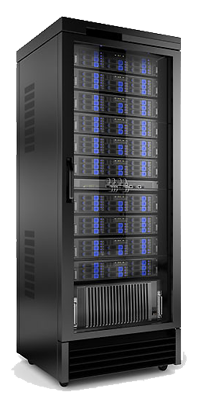Our Solutions
Infrastructure

Server
A server is a computer program or device that provides a service to another computer program and its user, also known as the client. In a data center, the physical computer that a server program runs on is also frequently referred to as a server. That machine might be a dedicated server or it might be used for other purposes.
A physical server is simply a computer that is used to run server software. A virtual server is a virtual representation of a physical server. Like a physical server, a virtual server includes its own operating system and applications. These are kept separate from any other virtual servers that might be running on the physical server.
The process of creating virtual machines involves installing a lightweight software component called a hypervisor onto a physical server. The hypervisor's job is to enable the physical server to function as a virtualization host. The virtualization host makes the physical server's hardware resources -- such as CPU time, memory, storage and network bandwidth -- available to one or more virtual machines.
Storage
Cloud storage is a model of computer data storage in which the digital data is stored in logical pools, said to be on "the cloud". The physical storage spans multiple servers (sometimes in multiple locations), and the physical environment is typically owned and managed by a hosting company. These cloud storage providers are responsible for keeping the data available and accessible, and the physical environment secured, protected, and running. People and organizations buy or lease storage capacity from the providers to store user, organization, or application data.
Cloud storage services may be accessed through a colocated cloud computing service, a web service application programming interface (API) or by applications that use the API, such as cloud desktop storage, a cloud storage gateway or Web-based content management systems.
Pricing for Cloud Storage services is based on what you use, including the amount of data you store, the duration for which you store it, the number of operations you perform on your data, and the network resources used when moving or accessing your data. For “cold” storage classes meant to store long-term, infrequently accessed data, there are also charges for retrieving data and early deletion of data.
Save costs without sacrificing performance by storing data across different storage classes. You can start with a class that matches your current use, then reconfigure for cost savings.
Standard Storage: Good for “hot” data that’s accessed frequently, including websites, streaming videos, and mobile apps.
Nearline Storage: Low cost. Good for data that can be stored for at least 30 days, including data backup and long-tail multimedia content.
Coldline Storage: Very low cost. Good for data that can be stored for at least 90 days, including disaster recovery.
Archive Storage: Lowest cost. Good for data that can be stored for at least 365 days, including regulatory archives.


Networking
A network consists of two or more computers that are linked in order to share resources (such as printers and CDs), exchange files, or allow electronic communications. The computers on a network may be linked through cables, telephone lines, radio waves, satellites, or infrared light beams.
Two very common types of networks include:
• Local Area Network (LAN)
• Wide Area Network (WAN)
You may also see references to a Metropolitan Area Networks (MAN), a Wireless LAN (WLAN), or a Wireless WAN (WWAN).
